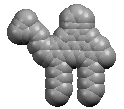PerlMol - Example: Peptide builder
Peptide builder sample script
By Ivan Tubert-Brohman, upon a suggestion by Ramón Garduño-Vázquez
Builds a 3D structure for a peptide given a sequence (the structure is essentialy linear; with some minor tweaks it could solve the protein-folding problem ;-)
It uses mdl molfiles. I know that for peptides PDB would make more sense, but for some reason I already had a few aminoacid structures in my drive as MDL molfiles and was too lazy to deal with PDB. Some things would have to be changed for it to generate a proper PDB file with the residue sequence numbers and such.
# usage: ./pep.pl <SEQUENCE> # prints an mdl molfile to stdout # curent version only supports the residues A,G,L,V
Files
- peptide_builder.pl - the program
- ala.mol - alanine with 3D coordinates
- gly.mol - glycine with 3D coordinates
- leu.mol - leucine with 3D coordinates
- val.mol - valine with 3D coordinates
- lava.mol - expected program output for ./peptide_builder LAVA
Code
#!/home/ivan/bin/perl # usage: ./pep.pl <SEQUENCE> # prints an mdl molfile to stdout # curent version only supports the residues A,G,L,V # the residues are assumed to be in the files listed below in %files, # which must have the atoms N, CA, and C as the first three atoms in the # file use strict; use warnings; #use diagnostics; use Chemistry::File::MDLMol; use Chemistry::File::SMARTS; use Chemistry::InternalCoords::Builder qw(build_zmat); { # the files with the template aminoacids (3D coords) my %files = ( A => 'ala.mol', V => 'val.mol', G => 'gly.mol', L => 'leu.mol', ); # This defines the essential part of an aminoacid my $patt = Chemistry::Pattern->parse('C((=O)CN([C,H])[H])O[H]', format => 'smarts'); my %aa; my ($c, $o, $ca, $n, $hn); # return a molecule object from an aminoacid given its one-letter code sub amino_acid { my ($code) = @_; return $aa{$code} if $aa{$code}; my $file = $files{$code} or die "unknown code '$code', stopping "; $aa{$code} = Chemistry::Mol->read($file); } # start a new chain from a residue (a Chemistry::Mol object). # returns the new chain (a Chemistry::Mol object) sub start_chain { my ($res) = @_; # clone because we don't want to destroy the template my $chain = safe_clone($res); # find out which atom is which $patt->match($chain) or die "didn't match, stopping "; my ($oh, $ho, $hnb); ($c, $o, $ca, $n, $hn, $hnb, $oh, $ho) = $patt->atom_map; # chop off the carboxyl OH $oh->delete; $ho->delete; # generate internal coordinates. build_zmat($chain, bfs => 0); $chain; } # add a new residue (a Chemistry::Mol object) to a chain sub add_residue { my ($chain, $res) = @_; # clone because we don't want to destroy the template $res = safe_clone($res); # find out which atom is which $patt->match($res) or die "didn't match, stopping "; my @map = $patt->atom_map; # delete the hydroxyl and an HN atom $_->delete for splice @map, 5; # generate internal coordinates. # The bfs => 0 is needed to make sure # that the first three atoms are N, CA, and C, so that we can use # them reliably for positioning the new residue with respect to # the previous one build_zmat($res, bfs => 0); # add the new residue $chain->combine($res); # since combine clones $res, we want to find the atoms of interest # in the new part of the chain, by "translating" the atom_map my ($c2, $o2, $ca2, $n2, $hn2) = map { $chain->by_id($_->id) } @map; # create the peptide bond $chain->new_bond(atoms => [$n2, $c], order => 1); # add some roughly reasonable internal coordinates to position the # new residue $n2 ->internal_coords($c, 1.5, $ca, 120, $o, 180); $ca2->internal_coords($n2, 1.5, $c, 120, $ca, 180); $c2 ->internal_coords($ca2, 1.5, $n2, 120, $c, 180); # make sure that the N is planar $hn2->internal_coords($n2, 1.1, $c, 120, $o, 180) if $hn2->symbol eq 'H'; # make sure it's not Proline # save the new terminal residue's atoms of interest ($c, $o, $ca, $n, $hn) = ($c2, $o2, $ca2, $n2, $hn2); } sub end_chain { my ($chain) = @_; # add the terminal hydroxyl group my $ox = $chain->new_atom( symbol => 'O', internal_coords => [ $c, 1.5, $ca, 120, $o, 180 ] ); my $h = $chain->new_atom( symbol => 'H', internal_coords => [ $ox, 1.1, $c, 105, $o, 0 ] ); $chain->new_bond(atoms => [$ox, $c], order => 1); $chain->new_bond(atoms => [$ox, $h], order => 1); # finally, calculate the cartesian coordinates for all the atoms in # the chain $_->internal_coords->add_cartesians for $chain->atoms; } } # this is like Chemistry::Mol::clone, but assigns a fresh ID to the cloned # molecule, atoms, and bonds. This should be added to Chemistry::Mol sub safe_clone { my ($mol) = @_; my $clone = $mol->clone; for ($clone, $clone->atoms, $clone->bonds) { # this uses the undocumented nextID method in Chemistry::Mol, # Chemistry::Atom, and Chemistry::Bond $_->id($_->nextID); } $clone; } # takes a sequence string such as "LAVA" and returns a Chemistry::Mol object sub build_sequence { my ($s) = @_; $s or die "no sequence, stopping "; my @seq = split //, $s; my $code = shift @seq; my $res = amino_acid($code); my $chain = start_chain($res); $chain->name($s); for my $code (@seq) { $res = amino_acid($code); add_residue($chain, $res); } end_chain($chain); return $chain; } ############################## # generate the structure and print it out as an MDL molfile my $chain = build_sequence(shift); print $chain->print(format => 'mdl');
